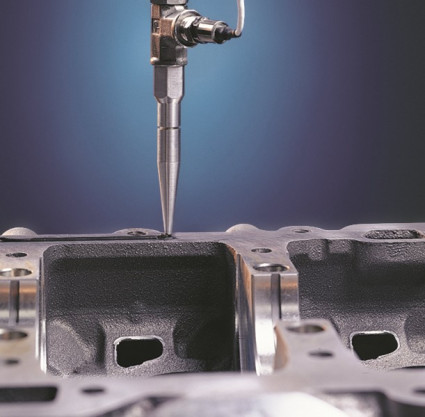Henkel is appearing at this year’s Productronica (November 12 to 15 in Munich, Germany), where it will be presenting, in particular, its liquid sealant and gasketing products for the automotive industry. With its two polyacrylate-based liquid gasketing products Loctite 5883 and Loctite 5810 B, Henkel is able to offer solutions which, thanks to their high flexibility and minimal permeability, ensure optimum results in the sealing of transmission control systems.
Seamless gasket application with Loctite 5883
Loctite 5883 is used, for example, to seal engine covers, oil pans and electric control covers. This UV-curing liquid gasket can be applied directly to the mating surface of components where it sets within 30 to 60 seconds. Its rapid curing capability means shorter cycle times, enabling process costs incurred by manufacturers to be substantially reduced. Moreover, Loctite 5883 ensures fast production of the assemblies involved because it eliminates the need to fabricate a separate gasket and place it between the mating components.
A further advantage of Loctite 5883 lies in the fact that the liquid gasket can be seamlessly applied. It is also up to ten times more resistant to engine oil than conventional silicone gaskets. The liquid sealant also offers good adhesion on both metal and plastic surfaces.
Reduced material costs with Loctite 5810 B
The polyacrylate liquid sealant Loctite 5810 B is especially suitable as a gasketing solution in automotive powertrain assemblies such as engines and transmissions. Using liquid gaskets of this type can reduce material costs by up to 95 percent compared to conventional preformed gaskets because the process can be fully automated. Loctite 5810 B is a moisture-curing sealant and adheres to almost every kind of surface, including metal and plastics. Moreover, Polyacrylate-based Loctite 5810 B is neutral in behavior. As a liquid gasket, it offers better oil resistance, minimal hydrocarbon permeability and fast curability.
Both Loctite 5883 and Loctite 5810 B reduce process costs for the manufacturer, increase productivity and enhance the performance of the gasketed products. With these two polyacrylate liquid gasketing products from Loctite, Henkel is thus able to contribute to the optimization of automotive assemblies, significantly improving on the performance levels achieved with silicone-based gaskets.
Source: Henkel
Romain’s opinion:
This kind of sealing technology can be easier to set-up as it does not mandatorily require base engine design modification like throat for putting a plastic seal. The only draw-back I see is in after-market, when opening the seal, it is needed to re-apply a new seal which has a cost. Do you think OEM will prefer using a standard seal of this kind of liquid seal? What are the selection criterion?




















